Blog, Fermented Foods
What is Water Kefir – 12 Steps to Making Probiotic Drinks Yourself
Today I’ll be teaching you about water kefir and how this natural fermented probiotic drink can improve the overall health of you, your children and entire family!
So what is kefir and why is it increasing in popularity throughout the world, especially among people who are become more health conscious? Have you heard of what probiotics can do for your health? If you have digestion issues, acne or skin problems, issues with absorption of nutrients, or would like to overall boost your health and wellness then this should be an article right up your ally. Below you’ll find my personal experience along with a 12 step guide I put together that teaches you how to make this healthy probiotic drink yourself. Learning what is kefir, it’s benefits, where it comes from (which is still a mystery today) and more has been a brand new learning experience for me and very fascinating for a number of reason that you’ll learn about. The quick links below will help you easily access the areas throughout this article.
Quick Links
- What is kefir
- My personal experience discovering water kefir
- Health benefits of water kefir
- History of Kefir Grains
- What to know and prepare before making your own kefir
- The beneficial bacterial and yeast strains found in water kefir
- Trent’s 12 step guide on how to make water kefir from home
- Scientific References and Links
What is water kefir
back to top
Kefir is a probiotic product that companies or you can make on your own by letting the kefir grains (more to come on this later) digest the sugars and other ingredients in the base product such as milk (raw is best) or sugar in mineral water which results in a fermented, effervescent drink that is super healthy for you! Kefir is a probiotic which means Pro= for, Biotic= life = life promoting. Probiotics helps restore healthy intestinal flora especially after taking anti-biotics which means Anti= against, Biotic= life= Against-life.
My story discovering water kefir
back to top
A few months ago one of my friends and health mentors mentioned learning more about fermented products and shared with me some of the health benefits of kefir upon the digestive system and the influence they have upon the good intestinal flora in our bodies. It wasn’t until last month, May 2012, that I started learning about the health benefits of Kefir. I didn’t realized then that there were two different major types of kefir grains; water kefir grains and milk kefir grains. Anyway, based upon our research you can’t “manufacture or create” your own kefir grains; instead you have to obtain your own kefir grains from someone who got their’s passed on to them and so on. I found this to be quite intriguing. If you were to go to the local health foods store like Good Earth, Real Foods Market or even Walmart all carry kefir powder that you can add to your base product, but doing so does not generate or create sustainable “living” kefir grains that grow and can be used over and over again if cared for.
So last month I came across an add in ksl.com from a nice lady in Provo Utah who had some extra kefir grains thinking there was only one type of kefir grains but I found out she was selling water kefir grains so I gave it a try. I had a great talk with the lady about how she cured herself from osteoporosis, how her family drinks kefir water every day and loves it and bunch of other stellar health topics. After our conversation I took off with my set of instructions in hand, my covered mason jar which contained the live water kefir grains within it’s already prepared batch of sugar/mineral water which the lady made for me ahead of time and I was set to get started.
Since then I’ve gone through 4 full cycles of making my own kefir water probiotic drinks that the whole family looks forward to drinking, well except Marcie…haaa She drinks it but doesn’t love it like me and the kids do 🙂 The kids call it “fizzy drink”.
There’s alot of water kefir recipes and milk – raw milk kefir recipes out on the web, but the water kefir recipe I use is below along with the images to guide you through on how to you can make this healthy drink yourself from the comfort of your own home. Overall it’s not too time consuming at all so I definitely recommend giving it a try and then leaving your comments below about your journey and experience along with the kefir creations you make. I’ve seen people add lemons, limes, berries, mango, etc…to their kefir water grains to add flavor bit more nutrition and variety to their kefir drink all of which produce a tasty and health probiotic drink that immensely improves your intestinal flora, your body’s ability to digest foods and a whole host of other health benefits. As you’ll see below, I simply add our favorite juice to the kefir water after is has gone through a 12 to 24 hr fermenting cycle.
Health benefits of water kefir
There are alot of health benefits of water kefir but the primary benefits include:
- increased ability to digest foods better
- improved intestinal flora in the gut
- enhances your immune system
- the good bacteria strains and good yeast strains help the body remove toxins from the body including destructive bacterias and yeasts.
- helps control facial acne in teens
- higher levels of naturally occurring b-vitamins in the final fermented kefir water such as biotin, niacin(B3),pyridoxine(B6) and folic acid by providing the enzyme lactase that is enhances the digestion of milk based foods which is a good sign for people who cannot otherwise digest milk.
- your skin’s overall appearance improves
- assists with predigesting the protein thereby enhancing protein digestion and absorption
- helps reduce the affects of acute – infectious diarrhea which is a major world health problem, responsible for several million deaths each year. While the majority of deaths occur amongst children in developing countries, it is estimated that up to 30% of the population even in developed countries are affected by food-borne diarrhea each year. Probiotics can potentially provide an important means to reduce these problems. Source
History of Kefir Grains
As I researched the health benefits of water and milk kefir products my wife and I continually came across references of getting your own kefir grains but article after article never spilled the beans about how to create your own kefir grains. Well, as I searched some more we discovered that the origin of kefir grains is still a mystery today and no one knows where the origin of kefir grains started. There’s some speculation about kefir grains being “manna” from heaven back in Moses’s day or that an angel gave them to Mohommed the prophet, but who knows….quite fascinating though! If you come across any more news about this I’m eager to know. Just share a comment below. Here’s some history I found:
“Kefir is one of the oldest cultured milk products in existence. It’s quite popular in Russia and the Caucasus. The history and going legends of kefir end up going back to the people of the northern slopes of the Caucasian Mountains. Apparently there is a legend that Mohammed gave kefir grains to the Orthodox people and taught them how to make kefir. The ‘Grains of the Prophet’ were guarded jealously since it was believed that they would lose their strength if the grains were given away and the secret of how to use them became common knowledge. Kefir grains were regarded as part of the family’s and tribe’s wealth and they were passed on from generation to generation. So, for centuries the people of the northern Caucasus enjoyed this food without sharing it with anyone else they came into contact with.
Other people occasionally heard strange tales of this unusual beverage which was said to have ‘magical’ properties. Marco Polo mentioned kefir in the chronicles of his travels in the East. However, kefir was forgotten outside the Caucasus for centuries until news spread of its use for the treatment of tuberculosis in sanatoria and for intestinal and stomach diseases. Russian doctors believed that kefir was beneficial for health and the first scientific studies for kefir were published at the end of the nineteenth century. However, kefir was extremely difficult to obtain and commercial production was not possible without first obtaining a source of grains.
The members of the All Russian Physician’s Society were determined to obtain kefir grains in order to make kefir readily available to their patients. Early this century a representative of the society approached two brothers called Blandov and asked them to procure some kefir grains. The Blandov’s owned and ran the Moscow Dairy, but they also had holdings in the Caucasus Mountain area, including cheese manufacturing factories in the town of Kislovodsk. The plan was to obtain a source of kefir grains and then produce kefir on an industrial scale in Moscow.
The Blandov’s were excited since they knew that they would be the only commercial producers of this much sought after product. The true story of the Blandov’s quest for the elusive kefir grains is below.
Nikolai Blandov sent a beautiful young employee, Irina Sakharova, to the court of a local prince, Bek-Mirza Barchorov. She was instructed to charm the prince and persuade him to give her some kefir grains. Unfortunately, everything did not go according to plan. The prince, fearing retribution for violating a religious law, had no intention of giving away any ‘Grains of the Prophet’. However, he was very taken with the young Irina and didn’t want to lose her either. Realising that they were not going to complete their mission, Irina and her party departed for Kislovodsk. However, they were stopped on the way home by mountain tribesmen who kidnapped Irina and took her back to the prince. Since it was a local custom to steal a bride, Irina was told that she was to marry Bek-Mirza Barchorov. Only a daring rescue mission mounted by agents of her employers saved Irina from the forced marriage.
The unlucky prince was catted before the Tsar who ruled that the prince was to give Irina ten pounds of kefir grains, to recompense her for the insults she had endured.
The kefir grains were taken to the Moscow Dairy and in September, 1908, the first bottles of kefir drink were offered for sale in Moscow. Small quantities of kefir were produced in several small towns in the area where there was a ready market for it, people mostly consume it for its alleged medicinal value. Commercial manufacture of kefir on a large scale began in Russia, in the 1930s. However, it is difficult to produce kefir by conventional methods on a commercial scale. Traditionally, kefir was made in cows or goats milk in sacks made from the hides of animals. Occasionally it was also made in clay pots or wooden buckets or oak vats and in some areas sheeps milk was also used. Usually the kefir sacks were hung in the sun during the day and brought back into the house at night, when they were hung near the door. Everyone who entered or left the house was expected to prod the sack with their foot to mix the contents. As kefir was removed more fresh milk was added, making the fermentation process continuous.
By the 1930’s kefir was being made as a set-type product which entailed growing a quantity of grains milk and then straining out the grains and adding the cultured milk to a larger batch of fresh milk. The mixture was incubated and, when set, allowed to cool. Unfortunately, this type of product was not as good as the one produced using the tradition home-style method. During the 1950’s workers at the All-Union Dairy Research Institute (VNIMI) developed a new method for commercial kefir production which gave a drink similar to that produced in the home by traditional methods. The kefir was produced by the stirred method. Fermentation, coagulation, agitation, ripening and cooling, were carried out in a large vessel, and then the kefir was bottled.
In 1973 the Minister of the Food Industry of the Soviet Union sent a letter to Irina Sakharova thanking her for bringing kefir to the Russian people. Presently, kefir is the most popular fermented milk in Russia. Various reports have stated that it accounts for between 65% and 80% of total fermented milk sales in Russia with production of over 1.2 million tons per year in 1988. The average yearly consumption of kefir in the Soviet Union was estimated at approximately 4.5 kilograms per person per year in the early 1980s. Currently kefir is being manufactured on a commercial scale in Czechoslovakia, Finland, Hungary, Norway, Poland, Sweden, Switzerland, Russia and various of the former soviet union states, Denmark, the United States, France, West Germany, Canada and parts of southeast Asia. In addition to plain kefir, many flavoured varieties are available, being especially popular in the United States.
The beneficial bacterial and yeast strains found in water kefir
Lactobacilli Strains in Water Kefir
- Lactobacillus galactose
- Lb. brevis
- Lb. casei subsp. casei
- Lb. paracasei subsp. paracasei
- Lb. casei subsp. Ramos
- Lb. casei subsp. tolerant
- Lb. coraciiform subsp. torquens
- Lb. fructose
- Lb. hilarities
- Lb. homophobia
- Lb. plantarum
- Lb. pseudo plantarum
- Lb. admonishes
Streptococci/lactococci Strains in Water Kefir
- Streptococcus cremeris
- Str. faecalis
- Str. lactis
- Leuconostoc mesenteroides
- Pediococcus damnosus
Yeast Strains in Water Kefir
- Saccharomyces cerevisiae
- Sacc. florentinus
- Sacc. pretoriensis
- Candida valida
- C. lambica
- Kloeckera apiculata
- Hansenula yalbensis
What to know and prepare for before making your own water kefir
- Always use clean utensils such as woods, plastics and glass are the best to use.
- Use a nylon or silicone strainer as metals are harmful to the grains.
- Use spring water for best results to produce the healthiest grains. Chlorine can be evaporated out of plain tap water if left to sit overnight but this is not recommended since most city water sources contain fluoride which is harmful to the grains.
- As a general rule of thumb use ONE Tablespoon sugar per ONE Tablespoon grains and ONE cup water.
- Once water/sugar mixture is ready, place the grains inside and cover with a cloth or papter towel to keep dusts and bugs out. Keep at room temperature for 18 to 48 hrs depending on temperature and taste buds. In the colder months it will take closer to 48 hrs. Avoid fermenting any longer than 48 hrs or you run the risk of starving the grains.
- Any sugar can be used as food for the grains as long as it is actually SUGAR and not a sugar replacement. Do not use honey. White, brown, sucanat, rapadura and cocnut sugar are all acceptable. I find it best to use a mixture of 1/2 sucanat and 1/2 white sugar and then every 3rd batch I use all sucanat which is easy for the water kefir grains to digest. I also use ONE teaspoon unsulphured molasses for flavor and minerals.
- To keep grains healthy they need to have minerals. This is why using spring water is so good for them. If you are using filtered water please add a pinch of baking soda of 1/4 piece of boiled egg shell or a pinch of sea salt to your solution.
- Once strained you may add juice or whatever flavorings you’d like and either refrigerate or leave out for an additional day to increase the fizzy “soda” effect. I bottle ours and let it sit a day after adding a 1/2 cup cranberry juice concentrate that we premix before and add it to ONE quart fermented kefir water.
- water or milk kefir grains
- clean glass jars, mason jars work good
- baking powder (if you’re using filtered water instead of spring water)
- unsulphured molasses (optional)
- sugar (sucanat is best – found at Good Earth or other health food stores) brown and while sugar will do as well
- A 1/4 cup measuring cup or one Tablespoon to measure with
- cloth or plastic coverings for the jars and a rubber band or lid to cover the kefir to keep out unwanted material
Trent’s 12 step guide on how to make water kefir from home
Step 1
As long as you follow the guidelines above there’s really no “wrong way” to make your kefir. What I do it use quart size mason jars, fill them up with spring water and then ad just a pinch of baking soda since the kefir grains like it and they grow better. So first gather all your supplies listed above and determine how many bottles of kefir you want to create. Fill up each bottle with spring water so there’s 2 inches left at the top of the bottle, add your pinch of baking soda and you’re set to go on to the next step!
Step 2
Go grab your kefir grains from the fridge if you’ve been storing them or if you just receive them for the first time I recommend rinsing them first in spring water NOT tap water.
Step 3
Now you’re ready to add 1/4 cup or roughly 4 tablespoons of kefir grains to your spring water.
Step 4
Once you’ve added your kefir grains to your water mixture it should look something like this picture below. Some people at this point add berries, limes, lemons, egg shells to their mix to increase the mineral content but it’s not necessary.
Step 5
Now go ahead and add 1/4 cup sugar or 4 tablespoons of sugar to your kefir water. I use sucanat purchased from Good Earth because it’s a more natural unrefined sugar. I place 3 tablespoons sucanat and 1 tablespoon white sugar.
Step 6
Since kefir grains thrive off of a mineral rich environment its good to add a teaspoon of unsulphured molasses to the kefir water. You don’t have to do this though if you don’t like the taste of molasses or if you are using unchlorinated spring water.
Step 7
Once you’ve added the unsulphured molasses to the kefir water your jar should look something like this:
Step 8
Now you’re ready to simply add your covering to the top of your glass jar. I use a plastic sandwich bag. Make sure to NOT screw the lid on too tight so the kefir water grains can breathe. Some people use a napkin or cloth and a rubber band for their covering and that’s fine too!
Step 9
Once you’ve covered your kefir water jars you’re read to set them either in a cupboard out of the light, or on your counter so they can begin the fermentation process for 12 to 24 hours. It’s important to put them in a place that has a temperature of around 72 to 80 degrees. If it’s cooler than that it takes longer to ferment…and if it’s too cold it just won’t ferment at all! If the temperature is warmer than 80 degrees or there about the fermentation process occurs faster I have found which is why a 12 hour fermentation time period would be okay. Usually though if the environment is around 72 degrees I always ferment my water kefir for 48 hours.
Step 10
Once you’ve made it this far you’ll notice that the mason jar on the right is done fermenting for about 18 hours and the bottle on the left is just getting started. Once your water kefir has sat between 12 to 24 hrs your bottle of kefir should look something like the one to the right if you’ve following my recipe exactly, if not yours will obviously look different. Feel free to be creative with your water kefir creations though. People have come up all types of water kefir creations out there so get creative, test things out to your liking and have fun!
Step 11
Now you’re ready to pour the kefir grains through a strainer as shown below and place the strained fermented water kefir into a new water kefir bottle for the last phase before drinking it. You could drink the water kefir at this point if you like it without much fizz but I personally, along with my wife and kids like it fizzy. So once I strain the grains I let the fermented water kefir sit for another 24 hours in a 72 degree environment (in our cupboard) and then the water kefir is fizzy!
Once you strain the kefir grains you’ll notice that the grains have double in quantity and have multiplied quite a bit within the last 24 hrs or less! You’re welcome to use the extra kefir grains to make more kefir, use them in smoothies or give them away or sell them. And yes you can eat them as well. I’ve never eaten them myself but I hear you can so for the really adventures type go ahead and post a comment below if you did and what your experience was!
Now, this step is optional but if you’d like go ahead and pour the juice of your choice into your fermented water kefir. I found that my family enjoys the taste of cranberry juice mixed in the water kefir. You can use whatever you’d like to use though. We first fill up the kefir bottle full of kefir so there’s about 4 inches left at the top of the bottle and then fill the rest up with the cranberry juice! After the bottles are filled up with the fermented water kefir plus the juice we let it site for one more day to create extra “fizzyness” or carbonation so it’s not as flat. This is not necessary to do so it just depends on your preference.
Step 12
Here’s the final product folks 🙂 I had my lovely wife Marcie go to Ikea and pick up some bottles so we could use them to easily keep our water kefir in. These kefir bottles work wonderfully! After we let the final water kefir sit for a day we place these bottles inside the fridge and drink them whenever we want.
Scientific References and Links
- http://users.sa.chariot.net.au/~dna/kefirpage.html
- http://magma.ca/~scimat/Foodmiblog.htm
- http://www.mesanders.com/probio_report.pdf (Joint FAO/WHO Expert Consultation on Evaluation of Health and Nutritional Properties of Probiotics in Food Including Powder Milk with Live Lactic Acid Bacteria, October 2001)
- http://www.torontoadvisors.com/ (this site has a list of people from locations all throughout the world willing to give you kefir grains)

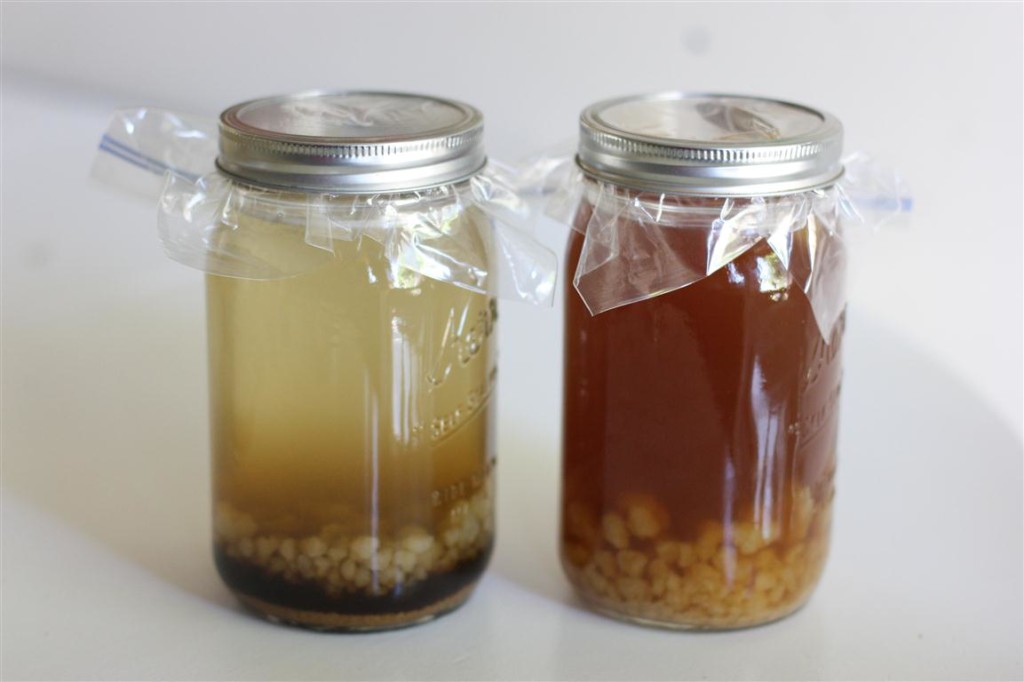

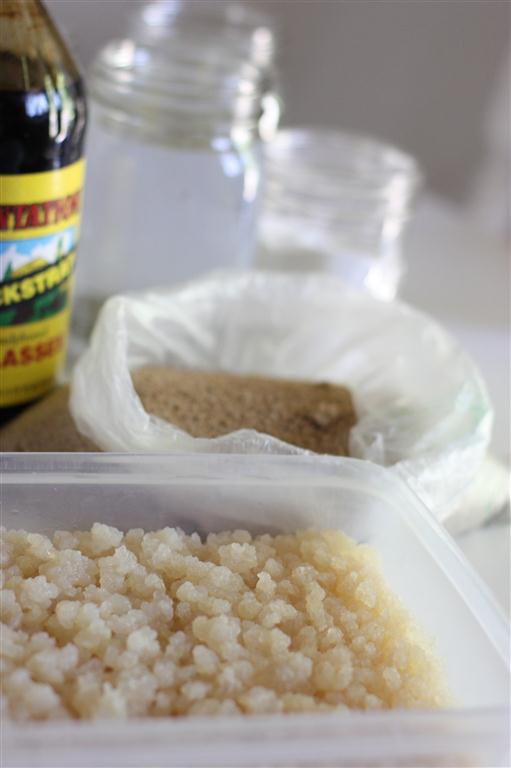

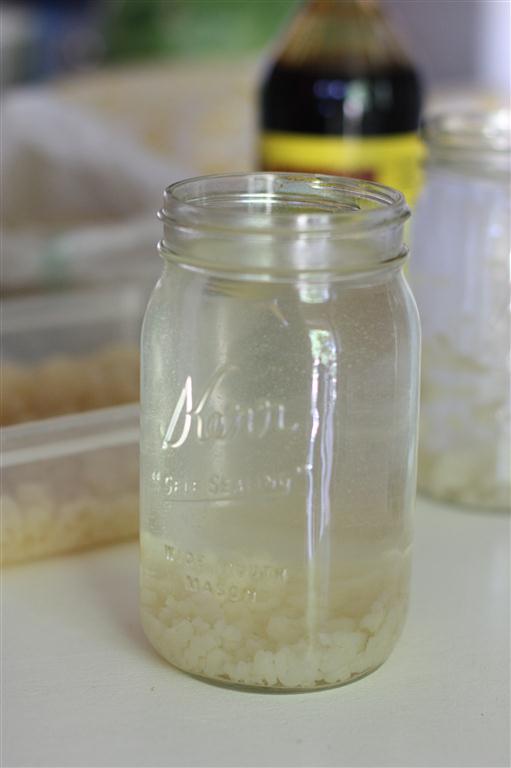
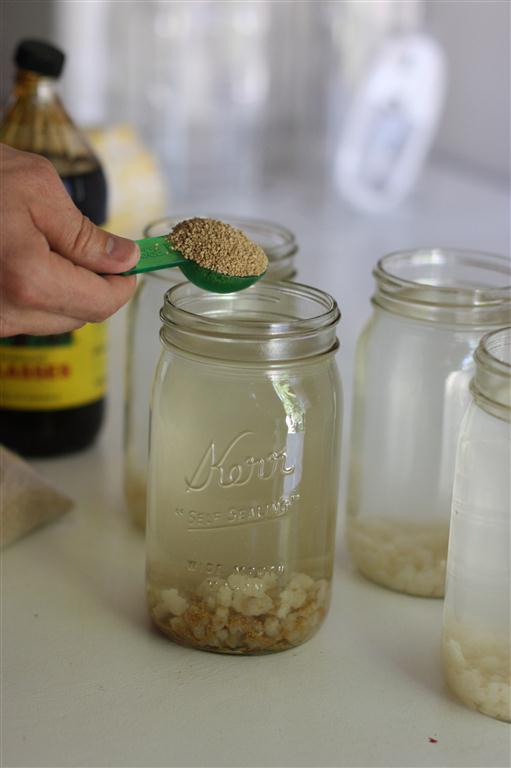
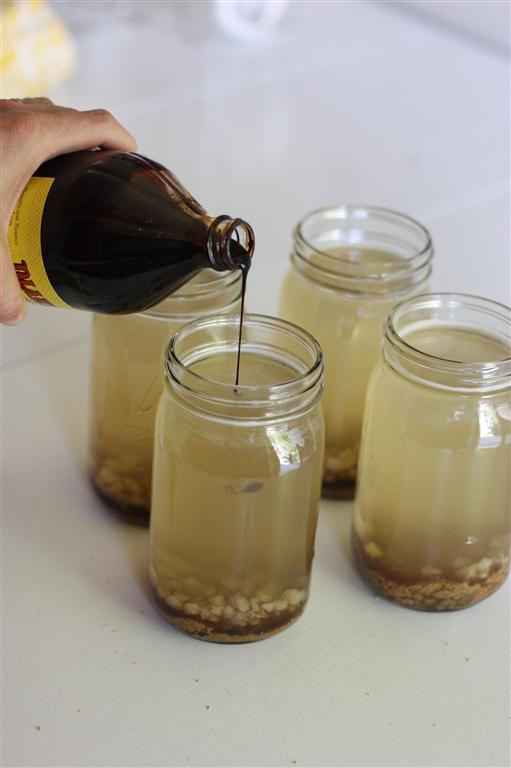
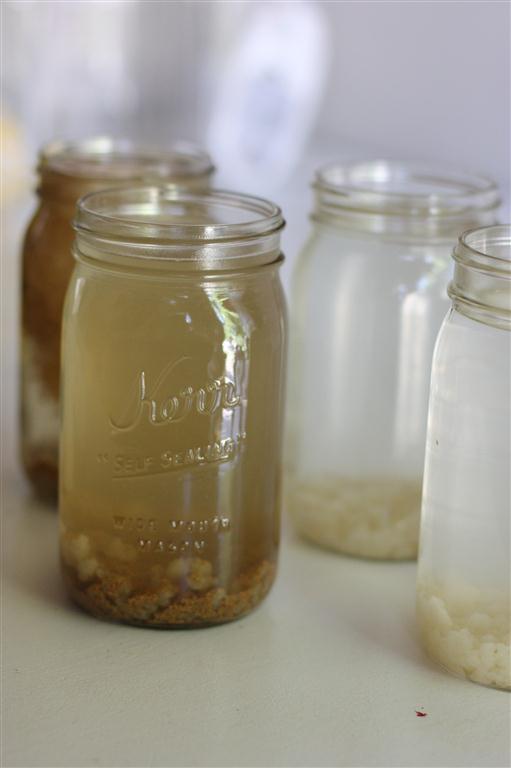
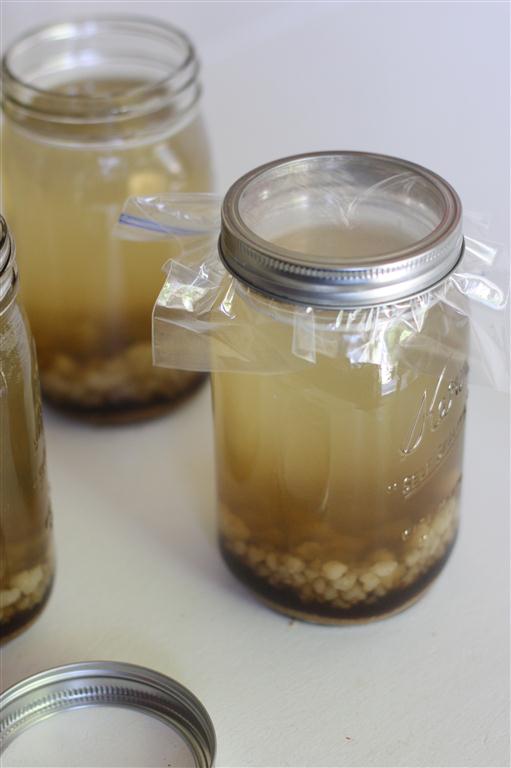





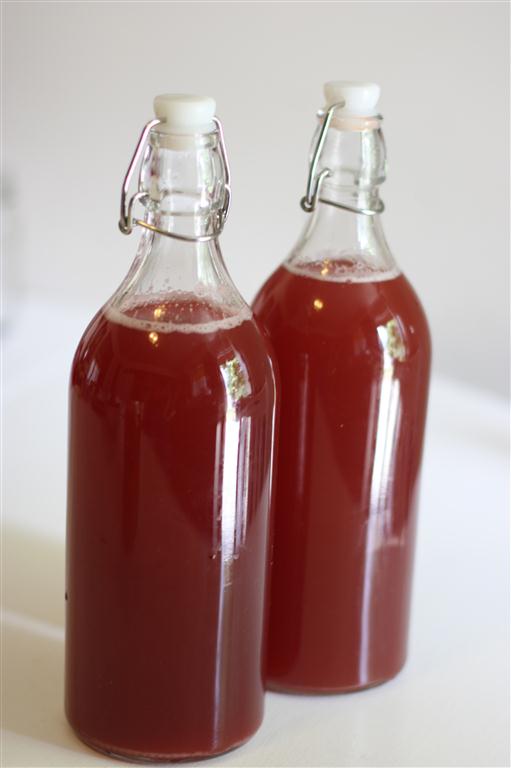
I tried Kefir a few years ago and took it for about a year, but would soak my kefir grains in whole milk. I never really liked it, but noticed many differences in how I felt. I remember leaving my grains to soak for too long and had to throw them out and never did re-start. I do like this version with the spring water/sugar/molasses. I might give it another try! Great pics and instructions.
Right on Jenny! Thanks for the experience and feedback. I’m trying the raw milk kefir right now and then will be adding it to this post. I’d have to say though the water kefir is my favorite between the two so far. Definitely keep us posted if you pick it up again and if you want any of the grains we have just let me know!
Wow, blown away by the article, site and content…which I’d love to read, but who has time? (Seriously, I will read every word at some point.) What’s the Kefir taste like without the cranberry? Do you actually feel a difference since you’ve been drinking it? So how much for the grains, and what amount/weight are we talking about?
When do you have time for all this???
You’re too funny Sharna 🙂 Thanks for the comment. The taste of Water Kefir without cranberry juice is pretty good in my opinion. I add the cranberry so the entire family likes it without having to prepare it differently 3 different ways. Without juice it has slight carbonation effect and the taste of ours has a little molasses taste to it since we add unsulphured molasses to it. It doesn’t taste sugary at all. It’s hard to compare it to what it tastes like because I haven’t tasted anything like it, but it’s good. You’ll have to try it out and let me know what you think it tastes like!
I got some grains from a friend and we followed your directions to the letter but my grains did not double and I am wondering if these grains can die if not handled properly. She had the grains for a while before she gave me some. How can I tell if they are healthy and good. I also ordered some grains from you on this web site so I can compare. thanks for any advice you can offer
Paula
Hi Paula! I received your order and will be shipping your grains out today. Yes, the grains can die if not taken care of and stored properly. The water kefir grains be be stored in mineral solution in the fridge for 30 to 60 days and can be reactivated as normal in sugar solution as outlined on the tutorial I prepared. Afterward the grains begin producing as normal. If the sugar digests and the kefir water has a malt taste to it and is NOT sugary you know the grains are working. If the kefir water is still sugary the grains are dead. Hope that helps. Any other question feel welcome to email, call or post another comment! Regards,
Trent
Thanks Trent! Hard to tell but once I recieve your grains I will be able to compare them with mine and I might be able to better tell if mine are dead! What is the mineral solution consist of? Im excited to get the grains will I receive them tomorrow?
thanks
Paula
The mineral solution consists of spring water, a few drops of trace minerals and a pinch of baking powder. Your water kefir grains will be shipped today so you should receive them either tomorrow or latest on Wednesday this week. Once you receive them you can get the grains started with a brand new batch of kefir water following the instructions on this site that I prepared okay. Also another thing to keep in mind is that kefir grains need time to acclimate to their environment so you may need to prepare a few more sugar solutions for them to be operating in full force. This may not be the case but I’m sharing this just in case okay. Good luck with your new grains and post a comment about your experiences and the fun you’re having with them. Take care!
Trent
How long is the kefir with cranberry good for once you put it in the fridge?
We drink it within 4 days normally, but you can store it for longer, around 1-2 weeks. I haven’t tried to store it longer than a week though.
What is in the actual grains? Do you know if they are gluten free (no barley, rye, oats, wheat, or spelt)?
Hi Robin,
The grains were handed down from another person and so on and so forth. They comprise of a unique matrix of yeasts to my understanding. You’d have to send the grains to a lab for tested of their exact makeup or do some research on the subject but at this point I would check out what I have researched and documented on the 12 step guide.
Thanks!
Trent
You say add baking powder for mineral content – did you mean baking soda? If not, I think baking powder that’s aluminum free should be recommended.
Thanks Paul. Yes, it should say baking soda. that’s what I use.
But I do like your idea of using molasses to boost mineral content while sweetening
Thanks Paul 🙂 How long have you been creating your own probiotic foods?
Do you still sell water kefir grains…or give away? I live in Price, UT, and am ready to get some. If you do, I would like to get some from you on our next trip to “the land northward”.
Hi Deanna,
Yes, we still sell water kefir grains. I can ship them to you, or you can pick up them up the next time you’re northward bound like you said 🙂 Just give me a ring at 801 seven zero nine 1499
Thanks,
Trent
Quick question, What do you do after making the Kefir?. Do you reuse the Kefir you have for another batch or do you throw it out. This sounds great and not to hard to do. I suffer from food allergies and will have to make changes soon. I try to eat healthier but is very hard to break what you know. Thanks for your insight on this. Have never heard of it. But willing to try.
Hi April,
After I make water kefir I make another batch, or “rest” the grains by storing them in spring water in the fridge.
Any other questions are welcome!
Thanks,
Trent
Great post! Really good info. I have been making water kefir for three years. I love it. I love that it can take the flavor of anything and infuse it into itself. I really love adding whole fruit to the secondary ferment. Recently I did a whole pear and a few spices. Delicious! Not sure if it was mentioned, but some of the cheaper swing top bottles, and even the ones you buy at home brew shops meant for beer, will explode if left to ferment too long. I prefer to ferment in Fido jars, or the French lemonade bottles with the swing top. They sell them at cost plus, and a slightly different brand at aldi grocery store, but both use the same bottle brand. They are very thick and strong. I have dropped several on asphalt and have never broken one.
Just saw your comment Ron. Thank you for the info and points on the bottles to you. I’ve experienced two of the flasks explode but not due to the fermentation but due to the top opening too quickly and hitting the glass bottle.
Hi, thanks for your guidelines, and I been making wonderful water kefir. Just today I divided by second time my reproduction, and decided to make a test, adding a little tiny piece of ginger to one of my jar, along with prescribed sugar, and apple chunks and done always before. Maybe it is not sparkling, so, I wonder, if anyone has done so, and what results they got by using ginger. I wonder if ginger could kill the culture! I’m trying to do some probiotic ginger beer, actualy! :))) At least only in one, so, I still have some other folks making bubbles to my health! Thanks again!
Thanks Bianca! Sounds like a great creation you tried with the ginger. I’ll have to give that a try too. Take care,
Trent
And, for anyone who may want to know, I add an Apple, I have quite acid but tasty and sweet apples, and 2 dried prunes, all cut in small pieces. Does not need to be too smal. Figure it out. And sugar and the baking soda, all in non chlorine, filtered tap water. My kefir tastes like a very mild cider, that I love! So, I’m drinking a healthy cider?! Oh, divine! I feel great drinking it, as I was having candida issues, and the water kefir came just in time! For me kefir is like the famous brand of Yakult, just home made. Folks, go for it! And I find the creatures funny! It’s making magical nature, transforming still water in sparkling. My friend defined it well: you are drinking some water with the farts of these things! I don’t mind! They are clean, and I remember my mother making yogurt using similar creatures years ago! I used to love it!